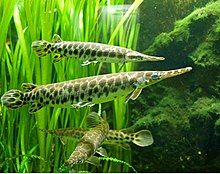Lepisosteiformes
| Lepisosteiformes Temporal range:
| |
|---|---|

| |
| Florida gar(Lepisosteus platyrhynchus) (Lepisosteidae) | |

| |
| Fossil ofScheenstia maximus(Lepidotidae) | |
| Scientific classification | |
| Domain: | Eukaryota |
| Kingdom: | Animalia |
| Phylum: | Chordata |
| Class: | Actinopterygii |
| Clade: | Ginglymodi |
| Clade: | Neoginglymodi |
| Order: | Lepisosteiformes Hay,1929 |
| Families | |
For other genera, see text | |
Lepisosteiformesis anorderofray-finned fishand the only living members of the cladeGinglymodi.Its only extant representatives are thegar(familyLepisosteidae), and it is defined as all members of Ginglymodi that are more closely related to gar than to the extinctSemionotiformes,the other major grouping of ginglymodians. They are one of two extant orders in the infraclassHolosteialongside theAmiiformes(now represented by only thebowfins).[2][1]
While represented only by the two extant genera of gar fromNorth America,the Lepisosteiformes are an ancient group known as far back as theEarly Jurassic,and formerly had a much larger range, being known from almost every continent. Considerable morphological diversity is known among extinct members compared to modern gar, from the superficially gar-likeObaichthyidaeto the semionotiform-likeLepidotidae,which were previously classified in theSemionotiformes.[3][4]
Evolution
[edit]The earliest known lepisosteiform is the marineLepidotesfrom the Early Jurassic ofGermany,which largely shares the original body plan ofGinglymodishared withSemionotiformes.[1]However, phylogenetic estimates suggest that the earliest lepisosteiforms diverged from their closest relatives in theMiddle Triassic.The mostbasallepisosteiform is thought to beKhoratichthysfrom the Late Jurassic or Early Cretaceous of Thailand, which is thought to have diverged from other members of the group during theLate Triassic.[5]Other studies suggest that the most basal member isNeosemionotusfrom the Early Cretaceous ofArgentina,which diverged from the rest of the group during the Early Jurassic.[6]
Numerous early lepisosteiforms (including basal lepisosteiforms such asKhoratichthysandLanxangichthys,lepidotids such asIsanichthys,and basal lepisosteoids such asThaiichthys) are known from the Late Jurassic and Early Cretaceous of Thailand andLaos,suggesting that what is nowSoutheast Asiamay have been an important region for early lepisosteiform evolution, and that ginglymodians were the dominant fish in freshwater ecosystems in the region at the time.[5]
It has been suggested that as is with basal ginglymodians and the Semionotiformes, the earliest lepisosteiforms were marine and independently colonized and diversified in freshwater ecosystems multiple times; first among the Lepidotidae, and then among the Lepisosteoidei. Two independent freshwater colonizations appear to have occurred among the lepisosteioids: one in Southeast Asia and one in WestGondwana.The latter included theObaichthyidae,close relatives of the gar.[6]
The ecology of the group including extinct members broader than that of living gars. Members ofLepidotidaein particular are strongly different from modern gars in having bulky bodies, with the large (up to 2 metres (6.6 ft)) lepidotidScheenstiadeveloping powerful jaws filled with rounded teeth that were likely used to crush shells (durophagy).[7]
Classification
[edit]- Order LepisosteiformesHay, 1929
- Genus†Adrianaichthys[8]
- Genus†Beiduyu[9]
- Genus†Khoratichthys[5]
- Genus†Lanxangichthys
- Genus†Neosemionotus
- Family†Lepidotidae
- Suborder LepisosteoideiLópez-Arbarello, 2012[1]
- Genus†Araripelepidotes
- Genus†Pliodetes[10]
- Genus†Thaiichthys
- Superfamily LepisosteoideaLópez-Arbarello, 2012[1]
- Family†Obaichthyidae
- FamilyLepisosteidae
References
[edit]- ^abcdeLópez-Arbarello, A. (2012)."Phylogenetic Interrelationships of Ginglymodian Fishes (Actinopterygii: Neopterygii)".PLOS ONE.7(7): e39370.Bibcode:2012PLoSO...739370L.doi:10.1371/journal.pone.0039370.PMC3394768.PMID22808031.
- ^"Order Summary for Lepisosteiformes".fishbase.mnhn.fr.Retrieved2023-11-25.
- ^López-Arbarello, Adriana (2012-07-11)."Phylogenetic Interrelationships of Ginglymodian Fishes (Actinopterygii: Neopterygii)".PLOS ONE.7(7): e39370.Bibcode:2012PLoSO...739370L.doi:10.1371/journal.pone.0039370.ISSN1932-6203.PMC3394768.PMID22808031.
- ^Grande, Lance (2010)."An empirical synthetic pattern study of gars (Lepisosteiformes) and closely related species, based mostly on skeletal anatomy. The resurrection of Holostei".Copeia.10(2A): 1–871.Retrieved2023-11-25.
- ^abcDeesri, U.; Jintasakul, P.; Cavin, L. (2016)."A new Ginglymodi (Actinopterygii, Holostei) from the Late Jurassic–Early Cretaceous of Thailand, with comments on the early diversification of Lepisosteiformes in Southeast Asia".Journal of Vertebrate Paleontology.36(6): e1225747.Bibcode:2016JVPal..36E5747D.doi:10.1080/02724634.2016.1225747.S2CID89359438.
- ^abCavin, Lionel; Deesri, Uthumporn; Olive, Sébastien (2019-07-22)."Scheenstia bernissartensis(Actinopterygii: Ginglymodi) from the Early Cretaceous of Bernissart, Belgium, with an appraisal of ginglymodian evolutionary history ".Journal of Systematic Palaeontology.18(6): 513–527.doi:10.1080/14772019.2019.1634649.ISSN1477-2019.S2CID199631685.
- ^Cawley, John J.; Marramà, Giuseppe; Carnevale, Giorgio; Villafaña, Jaime A.; López‐Romero, Faviel A.; Kriwet, Jürgen (February 2021)."Rise and fall of †Pycnodontiformes: Diversity, competition and extinction of a successful fish clade".Ecology and Evolution.11(4): 1769–1796.doi:10.1002/ece3.7168.ISSN2045-7758.PMC7882952.PMID33614003.
- ^de Paiva, H. C. L.; Gallo, V. (2018). "Quasimodichthysgen. nov. (Neopterygii: Semionotiformes): A morphological and ontogenetic study ".Journal of South American Earth Sciences.88:132–143.Bibcode:2018JSAES..88..132P.doi:10.1016/j.jsames.2018.08.010.S2CID134986658.
- ^Murray, A. M.; Xing, L.; Divay, J.; Liu, J.; Wang, F. (2015). "A Late Jurassic freshwater fish (Ginglymodi, Lepisosteiformes) from Qi gian g, Chongqing, China".Journal of Vertebrate Paleontology.35(2): e911187.Bibcode:2015JVPal..35E1187M.doi:10.1080/02724634.2014.911187.S2CID85946657.
- ^Wenz, S. (1999)."Pliodetes nigeriensis, gen. nov. et. sp. nov., a new semionotid fish from the Lower Cretaceous of Gadoufaoua (Niger Republic): phylogenetic comments".Systematics and Fossil Record.3(1): 107–120.

